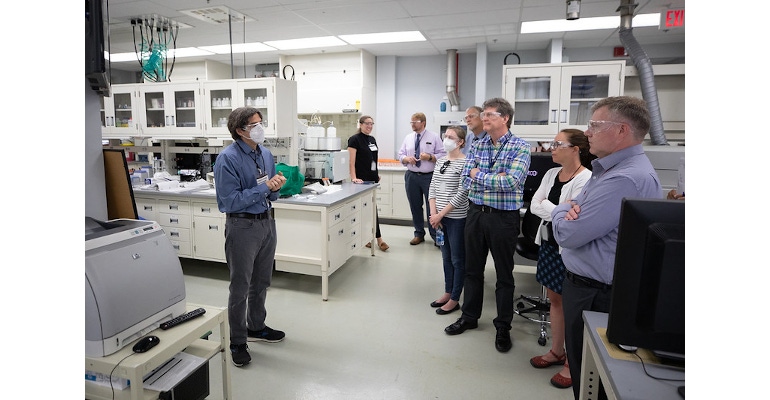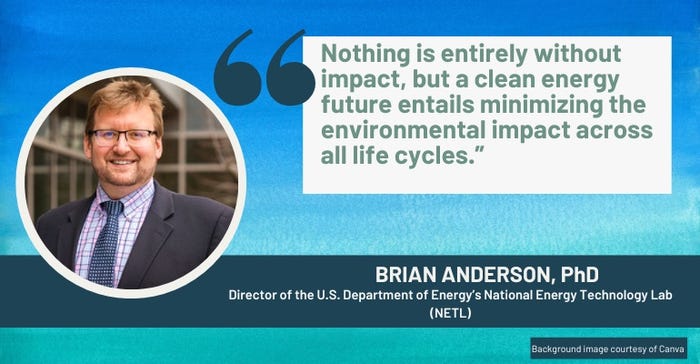Engineers, Industry Partners Needed for Progress on Clean Energy Goals
NETL is working to incentivize and partner with innovators to encourage development of clean energy solutions.
August 10, 2022

President Joe Biden has set three rigorous energy goals for the United States: achieve a 50-52% reduction from 2005 levels in economy-wide net greenhouse gas pollution in 2030, 100% carbon pollution-free electricity by 2035, and net-zero greenhouse gas emissions by no later than 2050. The Infrastructure Investment and Jobs Act passed last November, which includes $62 billion for clean energy development and deployment, provides some support for reaching these goals.
But the “government can’t do it alone,” Brian Anderson, PhD, director of the U.S. Department of Energy’s National Energy Technology Lab (NETL), told Design News. Government collaboration with the private sector, across several industries and involving engineers across several disciplines, will be critical to achieving these goals.
Anderson shared this sentiment at the recent Power 2022 conference. “My key message was that we need engineers, scientists, and other dedicated researchers to collaborate with industry, academia, and government in order to meet the President’s goals calling for a carbon-free power sector by 2035 and a net-zero carbon-emissions economy by 2050,” he stated in a press release.
Solutions need to ramp up quickly. “When you back up to today, for the steps needed to be taken to meet [these goals], they will only be achievable if movement takes place quickly,” Anderson told Design News.
He does acknowledge what he calls “large-scale challenges in policy and deployment,” but believes progress is possible through “understanding the technology pathways and incentives.” NETL can help with such support.
Engineers are also key to progress. Not only could they help develop new solutions for clean energy, but they can also lessen environmental impact through their own decisions as they design products and systems.
‘Broad Definition’ of Clean Energy
A clear definition of clean energy could offer engineers and innovators a starting point. But Anderson said the reality has to be a “broad definition.”
“Net-zero carbon is a large component of what I’d include in the definition,” he told Design News. However, “it also includes the entire supply chain, water, resources, emissions, and pollution. Nothing is entirely without impact, but a clean energy future entails minimizing the environmental impact across all life cycles.”
The Role of Engineers in Clean Energy and Beyond
Anderson urges engineers to think about life cycle analysis when developing any technology. “There are design decisions that can be made to achieve efficiency and a clean energy footprint,” he said.
As one might expect, “the power and transportation sectors have the biggest environmental burden,” he said. “We are always in need of good ideas.”
When it comes to developing energy solutions, Anderson reports seeing gains in integrating energy systems. For example, a microgrid could combine both heat and power, he said, as well as energy storage and multiple energy input sources. Additionally, these integrated energy systems will also have multiple product streams including electricity, heat, and carbon-free fuels, he added.
Resiliency can be built into energy supplies, particularly if they are distributed energy systems, he said. Solutions are also needed for energy storage and for assets that can be integrated into multifunctional manufacturing. Advanced manufacturing technologies like additive manufacturing are changing the paradigm across multiple supply chains, and the energy system will need to adapt to this changing landscape, he said.
Regarding materials, engineers should think through the full product life cycle and the imbedded environmental impacts in manufactured goods. They should also look for options for sourcing and be aware of the environmental impacts of their design choices. For instance, they could lower demand for a material that has a heavy environmental impact. “Engineers could minimize the amount of cobalt in batteries or lithium in storage,” he said.

The carbon-free energy sector impacts everything, he added. “If a professional is not directly involved in the power sector, their decisions still may involve power agreements and corporate decisions,” he said. “Different decisions for efficiency in manufacturing and use of different materials can play a role.”
At Power 2022, Anderson told engineers that developing innovative technologies to ensure no communities are left behind as the nation shifts to clean energy is a top NETL priority. According to a NETL press release, “Investments in carbon capture and sequestration, high-efficiency turbines, hydrogen hubs, and other decarbonization technology can generate good-paying jobs and growth in communities whose economies have been tied to fossil energy and coal-fired power plants while cleaning up the legacy of environmental issues and damage these communities have endured.”
How NETL Aims to Help
NETL is the DOE’s only government-owned, government-operated national lab, and it offers several options for collaborative partnerships and licensing agreements with business, industry, and academia. NETL has a robust network and focused programs on accelerating innovation deployment, Anderson told Design News. “We have a cadre of 600 industrial and laboratory partners in all 50 states,” he said. “One of our major focuses is our applied labs. Our mission is to make sure we have the right glide path from bench scale to prototype to deployment.”
Current projects include testing prototypes for carbon capture, management, and sequestration as well as working with advanced materials such as advanced alloys. Anderson encourages engineers to consider joining NETL’s team. “We are always in need of engineers with design skills,” he said.
NETL can also help by lowering risk for private sector innovators. “Markets and the flow of capital need incentives,” Anderson said. “NETL can ensure investments are made to lower risk for private sector uptake. Because the Infrastructure bill focuses on hubs, our goal is to ensure investments happen so that the private sector can accelerate technologies.
“We are right at the beginning, and pieces are there, but cost and risk need to come down,” he added.
About the Author(s)
You May Also Like





